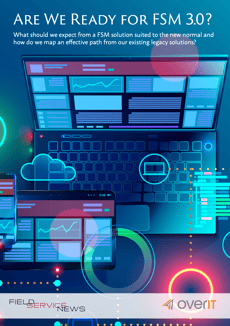UK small and medium sized food businesses are feeling the pressure for customer deliveries in the lead up to Christmas, according to new research released by Vimcar.
AUTHOR ARCHIVES: Field Service News
About the Author:
Field Service News is the world's leading publication for dedicated to the field service read by over field service professionals across the globe. If you are a field service practitioner you may qualify for a complimentary industry subscription - visit fieldservicenews.com/subscribe now!
Dec 17, 2021 • News • fleet management • UK • Covid-19 • Managing the Mobile Workforce • EMEA • VIMCAR
UK small and medium sized food businesses are feeling the pressure for customer deliveries in the lead up to Christmas, according to new research released by Vimcar.Over half of those surveyed have experienced an increased demand for food deliveries in the lead up to Christmas compared with the last two years.
This pre-Christmas rush is putting clear pressure on deliveries and demand on fleets, with almost 90% of those surveyed offering a delivery service for their customers. A need which has been galvanised by a change in customers’ purchasing habits since the start of the pandemic, with many now expecting delivery options to be available as standard, rather than as an additional option.
OVER HALF OF FOOD DELIVERY BUSINESSES ARE EXPERIENCING A HIGHER DEMAND FOR DELIVERIES THIS CHRISTMAS, COMPARED TO THE LAST TWO YEARS
Undertaken by Vimcar, the fleet management software for SMEs, the survey comes at a time when food retailers are needing to increase their fleet size (93%) to keep up with demand, but are grappling with the impact of delivery driver shortages. Furthermore, almost all (96%) food businesses currently running fleets to fulfil delivery needs, expect their costs to increase between now and Christmas.
Despite the increased pressure and challenges facing SME food retailers, the majority of respondents (78%) are feeling optimistic about business performance for the Christmas period 2021, as a result of the increase in demand and the lifting of COVID restrictions in comparison to 2020.
Sami Eric, UK Country Manager at Vimcar said: “It is really uplifting to see that small and medium sized food retailers are thriving in the run up to Christmas, especially after a very challenging couple of years. With these higher demands comes higher expectations for businesses to meet. This research shows the challenges that the food industry is facing during the busiest time of the year, and the need for customers to be understanding of the changing landscape to which businesses are adapting to.”
Eric added: “As pressure mounts, efficient fleet management will be crucial in helping SMEs to offset rising fleet costs as well as maximise the investment they have made into new delivery services. Poorly managed fleets and drivers can quickly drain a business’ costs and resources, so implementing a fleet management tool is vital to simplify time spent on fleet admin and maintenance.”
Further Reading:
- Read more about Managing the Mobile Workforce @ www.fieldservicenews.com/managing-the-mobile-workforce
- Read more about Fleet Management @ www.fieldservicenews.com/fleet-management
- Learn more about Vimcar @ vimcar.co.uk
- Find our more about Aircargo Transport @ www.aircargo-transport.eu
- Follow Vimcar on Twitter @ twitter.com/goVimcar
Dec 16, 2021 • News • Digital Transformation • IFS • Technology • GLOBAL
IFS, the global cloud enterprise software company, has announced the launch of IFS assyst 11.4. This latest update is set to deliver the ability for companies to adopt and deploy workflow technology more broadly within their business. A single...
IFS, the global cloud enterprise software company, has announced the launch of IFS assyst 11.4. This latest update is set to deliver the ability for companies to adopt and deploy workflow technology more broadly within their business. A single pricing model, as well as a simplified deployment model, will ensure business value is delivered within weeks of adoption.
IFS assyst 11.4 will also deliver a considerable set of new capabilities to help organisations standardise, improve, and automate service management workflows simply and effectively. In this first release since IFS acquired Axios Systems in June 2021, the vendor marks a key milestone in its mission to deliver innovation and customer value to all its customers regardless of size.
With the new release IFS vows to simplify pricing, licensing, and deployment to keep to its promise to deliver value and great experience
As the digital imperative accelerates and becomes the backbone of business transformation, companies need to deliver rich customer and employee experiences. By extending the benefits of IT Service Management (ITSM) to the wider enterprise thus evolving into Enterprise Service Management, IFS assyst 11.4 focuses on secure and automated self-service, putting the employee experience at the heart of any digital transformation strategy from IT, HR, and finance, to facilities and beyond.
“Digitising processes and building effectiveness through workflows is a fundamental pillar of any company’s digital transformation journey. Achieving this across the entire enterprise has until now been complex and expensive, and therefore limited to the IT function,” said Martin Schirmer, President, IFS assyst. “With assyst 11.4, we have tackled some fundamental roadblocks from pricing, to contracting, and deployment - all of which will make it simpler and faster for an organisation to scale up in the roll out of the technology.”
With this release, assyst has extended the omnichannel experience, advancing its chatbot and providing a mobile app for self-service. This means that employees can get access to the help they need wherever they are working, allowing them to focus on more complex or pressing priorities.
Key capabilities of IFS assyst 11.4 include:
-
Over 100 predefined service workflows for improved time to value
-
Low code approach to defining & maintaining service workflows
-
A consumer-standard user-interface, intuitive, and easy to navigate
-
Simple cost-effective pricing for easy enterprise-wide deployment
-
Integration with collaboration platforms like Microsoft Teams
“The release of IFS assyst 11.4 is the result of an incredible amount of hard work and investment from the IFS team over a short space of time,” continued Schirmer. “IFS is customer obsessed and with this release we are staying true to our north star, bringing enhanced service capabilities to companies anytime, anywhere.”
IFS assyst 11.4 is available immediately globally for customers to purchase. To learn more, please visit: https://info.axiossystems.com/assyst-11.4-broadcast
Further Reading:
- Find out more about IFS @ www.ifs.com/
- Read more about IFS on Field Service News @ https://www.fieldservicenews.com/ifs
- Read more about Digital Transformation @ www.fieldservicenews.com/digital-transformation
- Learn more about of IFS Assyst 11.4 @ info.axiossystems.com/assyst-11.4-broadcast
- Follow IFS on Twitter @ https://twitter.com/ifs
Dec 15, 2021 • News • Artificial intelligence • Automation • Ericsson • Telecommunications • EMEA • VONAGE
Ericsson (NASDAQ: ERIC) has entered into an agreement to acquire Vonage Holdings Corp. (NASDAQ: VG) for USD 21 per share. This represents a total acquisition price of approximately USD 6.2 billion (Enterprise Value).
Ericsson (NASDAQ: ERIC) has entered into an agreement to acquire Vonage Holdings Corp. (NASDAQ: VG) for USD 21 per share. This represents a total acquisition price of approximately USD 6.2 billion (Enterprise Value).
The merger agreement was approved unanimously by the Board of Vonage. The transaction builds upon Ericsson’s stated intent to expand globally in wireless enterprise, offering existing customers an increased share of a market valued at USD 700 billion by 2030.
THE ACQUISITION UNDERLINES ERICSSON STRATEGY TO EXPAND ITS PRESENCE IN WIRELESS ENTERPRISE AND BROADEN ITS GLOBAL OFFERINGS
Börje Ekholm, President and CEO of Ericsson, says: “The core of our strategy is to build leading mobile networks through technology leadership. This provides the foundation to build an enterprise business. The acquisition of Vonage is the next step in delivering on that strategic priority. Vonage gives us a platform to help our customers monetize the investments in the network, benefitting developers and businesses. Imagine putting the power and capabilities of 5G, the biggest global innovation platform, at the fingertips of developers. Then back it with Vonage’s advanced capabilities, in a world of 8 billion connected devices. Today we are making that possible.”
“Today Network APIs are an established market for messaging, voice and video, but with a significant potential to capitalise on new 4G and 5G capabilities. Vonage’s strong developer ecosystem will get access to 4G and 5G network APIs, exposed in a simple and globally unified way. This will allow them to develop new innovative global offerings. Communication Service Providers will be able to better monetize their investments in network infrastructure by creating new API driven revenues. Finally, businesses will benefit from the 5G performance, impacting operational performance, and share in new value coming from applications on top of the network.”
Rory Read, CEO of Vonage, says: “Ericsson and Vonage have a shared ambition to accelerate our long-term growth strategy. The convergence of the internet, mobility, the cloud and powerful 5G networks are forming the digital transformation and intelligent communications wave, which is driving a secular change in the way businesses operate. The combination of our two companies offers exciting opportunities for customers, partners, developers and team members to capture this next wave.”
“We believe joining Ericsson is in the best interests of our shareholders and is a testament to Vonage’s leadership position in business cloud communications, our innovative product portfolio, and outstanding team.”
For Ericsson, the acquisition builds on the success of the integration of Cradlepoint in September 2020. Cradlepoint has continued to develop strongly under Ericsson’s ownership.
Vonage and the Vonage Communications Platform (VCP)Vonage, a global provider of cloud-based communications, has a strong track record of growth and margin evolution. Sales were USD 1.4 billion in the 12-month period to 30 September 2021, and over the same period, Vonage delivered an adjusted EBITDA margin of 14% and free cash flow of USD 109 million.
The cloud-based Vonage Communications Platform (VCP) serves over 120,000 customers and more than one million registered developers globally. The API (Application Programming Interface) platform within VCP allows developers to embed high quality communications - including messaging, voice and video - into applications and products, without back-end infrastructure or interfaces. Vonage also provides Unified Communications as a Service (UCaaS) and Contact Center as a Service (CCaaS) solutions as part of the Vonage Communications Platform.
VCP accounts for approximately 80% of Vonage’s current revenues and delivered revenue growth in excess of 20% in the three-year period to 2020, with adjusted EBITDA margins moving from -19% in 2018 to break-even in the 12-month period to 30 September 2021. Vonage’s management team projects annual growth of over 20% for VCP in the coming years.
Ericsson and Vonage – creating a winning combination
Vonage’s presence in the Communication Platform as a Service (CPaaS) segment will provide Ericsson with an opportunity to access a complementary, substantial and high growth segment. With increasing investments in 4G and 5G - and a flourishing ecosystem of new applications and use cases leveraging the power of modern networks - demand from enterprises for programmable networks has been accelerating. CPaaS technologies democratize network access by offering API enabled communications services. The CPaaS market is expected to reach USD 22 billion by 2025, growing at 30% annually. In addition, Ericsson’s global leadership in 5G technology is expected to provide access to the developing space for open network APIs, which is expected to reach at least USD 8 billion by the end of the decade with a strong growth profile. CSP customers will also benefit from monetizing their network investments, optimizing the user experience and stimulating additional growth opportunities with new and advanced global network APIs and access to Vonage’s unified communications and contact center solutions.
The combination of Vonage’s customer base and developer community and Ericsson’s deep network expertise, 26,000 R&D specialists and global reach create opportunities to accelerate standalone strategies and innovation in the market. This includes accelerating enterprise digitalization and developing advanced APIs made possible by 5G; putting the power of the wireless network and communications at the finger-tips of the developer. Such APIs can be applied to help ensure the quality of critical services like telemedicine, immersive virtual education and autonomous vehicles as well as experiential performance benefits in gaming, augmented and extended reality, over wireless.
In the longer term, Ericsson intends to offer value benefits to the full ecosystem – telecom operators, developers, and businesses – by creating a global platform for open network innovation, built on Ericsson and Vonage’s complementary solutions.
Overview of the transaction
The acquisition will be conducted by means of a merger agreement through which Ericsson will acquire all of Vonage’s outstanding shares at an all-cash price of USD 21 per share. The merger consideration represents a premium of 28% to Vonage’s closing share price on 19 November 2021 of USD 16.37 per share, and a premium of 34% to the volume-weighted average share price over the 3 months to 19 November 2021 of USD 15.71 per share.
The acquisition will be financed through Ericsson’s existing cash resources, which amounted to SEK 88 billion as of 30 September 2021 on a gross basis, and SEK 56 billion on a net basis as of the same date.
The transaction is expected to deliver near-term revenue synergy opportunities, including white-labelling and cross-selling of the combined product portfolio estimated to contribute USD 0.4 billion. by 2025. Ericsson also expects to achieve some cost efficiencies following completion of the transaction.
The transaction is expected to be accretive to EPS (excluding non-cash amortization impacts) and free cash flow before M&A from 2024 onwards.
On completion, Vonage will become a wholly owned subsidiary of Ericsson and will continue to operate under its existing name. It will be reported as a separate segment in Ericsson accounts. Vonage is headquartered in Holmdel, New Jersey in the United States with 2,200 employees throughout the United States, EMEA and APAC. Vonage’s employees will remain with the company and the Vonage CEO Rory Read will join the Executive Team of Ericsson, reporting to CEO, Börje Ekholm. Read joined Vonage as CEO in July 2020. With more than three decades’ global technology industry experience, Read was previously Chief Operating Executive for Dell Technologies and before that, CEO of Advanced Micro Devices (AMD).
Ericsson remains fully committed to previously communicated financial targets, including long-term EBITA margins of 15-18%; long term FCF before M&A of 9-12% of sales; and a 2022 target EBIT margin of 12-14% for Ericsson Group excluding Vonage.
Completion of the transaction is subject to Vonage shareholder approval, regulatory approvals and other customary conditions and is expected within the first half of 2022.
Further Reading:
- Read more about Digital Transformation @ www.fieldservicenews.com/digital-transformation
- Read more about Ericsson on Field Service News @ www.fieldservicenews.com/ericsson
- Read more about Telecommunications on FSN @ www.fieldservicenews.com/telecommunications
- Find out more about Ericsson @ www.ericsson.com
- Learn more about Vonage @ www.vonage.co.uk
- Follow Ericsson on Twitter @ twitter.com/Ericsson
Dec 14, 2021 • Features • White Paper • OverIT • Covid-19 • Servitization and Advanced Services
In the second feature from a white paper we recently published in partnership with OverIT, we take a look at what tools are included in the new FSM solutions and how they have evolved from the previous iteration of FSM software that we are currently...
In the second feature from a white paper we recently published in partnership with OverIT, we take a look at what tools are included in the new FSM solutions and how they have evolved from the previous iteration of FSM software that we are currently using.

This feature is just one short excerpt from a recent white paper we published in partnership with OverIT.
www.fieldservicenews.com subscribers can read the full white paper now by hitting the button below.
If you are yet to subscribe you can do so for free by hitting the button and registering for our complimentary subscription tier FSN Standard on a dedicated page that provides you instant access to this white paper PLUS you will also be able to access our monthly selection of premium resources as soo as you are registered.

Data usage note: By accessing this content you consent to the contact details submitted when you registered as a subscriber to fieldservicenews.com to be shared withOverIT, sponsor of this premium content, who may contact you for legitimate business reasons to discuss the content of this white paper, as per the terms and conditions of your subscription agreement which you opted into in line with GDPR regulations and is an ongoing condition of subscription.
Having laid out the case that we are now entering a new era of field service, one which will fully harness the technologies and tools embedded within next-generation FSM solutions, let us now take a look at what tools are included in such systems and how they have evolved from the previous iteration of FSM software that is currently in place.
DATA INTEGRATION
Field service has always been a complex beast with many moving parts. However, modern field service in some respects is more complicated than ever due to the various systems of record (SOR) that may be in place. In previous iterations of FSM solutions, all too often, field service operations remained in a silo. Today, however, the benefit and value of widely available data flow across multiple business units are becoming increasingly acknowledged.
Therefore, there must be the potential to import and export data from one system to another within any modern FSM solution. Whether feeding into a CRM for sales, an ERP for resource planning, or even into a SOR that sits across production and R&D to drive forward product improvements, easy integration across non-service focused systems is critical.
GIS CAPABILITIES / INTEGRATION
Geographic Information Systems (GIS) has become an increasingly important part of many field service organizations workflows. However, while incredibly valuable, GIS data may come from multiple data sources, potentially stored in different SORs.
In the fast-moving world of field service, particularly if we are looking at reactive emergency response scenarios, then the ability to surface data from multiple sources both in the back office and, most notably for the engineer in the field, is crucial.
Although inclusion of GIS capability within next-gen FSM solutions like Geocall is relatively new, this practice is happening more frequently and will likely become the standard. While this may not be relevant for every industry vertical, within specific sectors such as Oil and Gas or Utilities, this could be a real game- changer that we will see emerge in the FSM 3.0.
SCHEDULING OPTIMIZATION
The old mantra of getting the right engineer, with the right skills, to the right job, at the right time will never fade as being the most central tenet of field service management and indeed service delivery as a whole. Across the last decade, we have seen tremendous strides made in scheduling with various approaches such as truly dynamic optimized scheduling and Darwinian algorithm-based scheduling. Such algorithm-based scheduling is paving the way for the increasingly widespread adoption of Robotic Process Automation (RPA) and AI leveraging the support of field service processes.
However, such sophisticated solutions are not always the right choice for each company or even for each type of service a single organization may have within its portfolio. The more sophisticated solutions are fantastic, for example, in dealing with large-scale service workflows, with large teams of field service engineers. They are also exceptionally effective in scenarios where there
may be complex requirements to place the right combination of skills across multiple engineers to meet the needs of the job.
In each of the above scenarios, we could see a different use case. In the first scenario, we could view an optimized scheduling engine as an opportunity to automate much of the dispatch workload, allowing the service organization to place human resources in roles that are more aligned to revenue generation than cost reduction. In such an instance, the human dispatcher adopts the role of supervisor. For example, ensuring the automation process is handling 80% of calls within standard parameters while taking control of the 20% that require a more nuanced approach (in line with the Pareto or 80:20 rule).
In the second scenario, where such a nuanced understanding of a more complex service scenario is required, we may consider assisted scheduling rather than automation.
The flexibility to have both solutions covered within a next-gen FSM solution is essential. However, what differentiates the new breed of FSM solution to many of the older legacy solutions is that scheduling tools, whether fully automated or assisted scheduling, should now always be expected to be dynamic. A dynamic solution can react to real-time data from the field, including engineer updates, traffic information, and customer data. This is a crucial aspect of next- gen solutions and allows for the work schedule to be constantly optimized.
EFFECTIVE REPORTING TOOLS
As we discussed earlier in the paper, the importance of data flowing between your FSM and other SOR has never been more critical. Service operations are now becoming a key driver in multiple core aspects of the broader business operations, and as such, the flow of information across the business must be seamless. Directly aligned to the importance of that data flow moving beyond the traditional silos is the ability for data to be surfaced in an easy yet meaningful way.
Within the context of next-gen FSM solutions, this primarily relates to dashboards that can be customizable for various levels of management allowing them to see the data in the manner they need. Modern-day reporting should give us the tools to simultaneously cut out the background noise of data unnecessary to the job at hand while tapping into the vast data lakes that are the bi-product of modern-day service management and bringing to the fore the data insight that is of use. It is also an expectation of next-gen FSM solutions such as Geocall to utilize different algorithms to translate the data into multiple use cases.
To illustrate this, let us look at an example most field service leaders would be familiar with, capacity planning.
We may have several data sets that we utilize in our capacity planning, say operations metrics that give us mean-time-per-job and technician utilization time. Alongside this, we may have customer job schedule data by volume and location. Then we may also have historical asset data that outlines the complexity of a given task.
In a next-gen FSM solution, we can apply different scheduling models, which allows us to compare and contrast based on various priorities and parameters. In essence, it is a glimpse into the future to see what could work and what may not.
In one scenario, we could run a model based on equity distribution to apportion workload fairly across all resources. Alternatively, we may want to run the same data against a logistic optimization to try to reduce travel and reduce time and reduce cost for the business.
In either scenario, we may want to factor in contingency capacity to accommodate any emergency work that comes in to ensure we have appropriate resources available to offer our customers total service support whenever called upon.
This scenario is just a brief example of the importance of effective reporting tools for service operations. The ability for a service leader to ask, “I want to make a change, what’s the impact?” and to effectively model out the answer to that question is a cornerstone of next-gen FSM.
MOBILE CAPABILITY
As we mentioned earlier in this paper, one of the significant shifts from FSM 1.0 to FSM2.0 was the inclusion of mobile. In the current status quo there is widespread provision of mobile solutions in the iterations of FSM solutions. However, next-gen solutions greatly magnify the complexity of such elements.
It is critical here to note that the complexity should always remain under the bonnet. Ultimately, the more sophisticated the technology on offer is, the more intuitive and seamless the experience should be for the end-user.
With this in mind, the mobile app of 2021 looks very different from those we would see just a few years ago, which were often little more than glorified push notifications showcasing job updates.
A modern FSM embedded mobile app should empower the engineer to capture accurate materials or asset data. It should guide them through structured workflows based on the job at hand while pulling in data from the asset itself.
It should play a pivotal role in ensuring that health and safety standards are met every time by placing clear checklists that technicians must complete before releasing additional information to the engineer. It should allow for a seamless customer interaction process- from having direct access for the engineer to order parts required when on-site, through the automated dispatch of invoices on receipt of an e-signature.
And returning to our concept of making the point of service as seamless as possible, the very best modern systems can do so in a truly dynamic fashion.
In Geocall, for example, the screen presents a truly dynamic experience for the field engineer or technician. The mobile solution understands the type of operation being undertaken and the most appropriate associated forms to capture the required data. Hotlinks are provided to the most relevant information within the knowledge library. The potential to record a solution to a currently unlisted problem allows the service organization to improve their knowledge base continuously.
The longer technicians use this tool, the more powerful it becomes.
And perhaps the most essential element of all, when it comes to identifying modern FSM technology, is that the mobile app links seamlessly to a virtual collaboration tool
VIRTUAL COLLABORATION / AUGMENTED REALITY
In the first section of this paper, we touched on how one of the primary shifts we will see as the dust settles and the new normal of field service begins to crystallize, is the more extensive use and many forms of remote service delivery will continue.This will take many forms. It may become a tool that technicians use for empowering self-service and self-maintenance for the customer. Workers may utilize it as the first level of support and enhanced triage tool. It may also support engineers in the field should they face an issue new to them requiring guidance from a more experienced colleague.
There are numerous papers dedicated to remote service tools available already on www.fieldservicenews.com, which are essential reading for all service companies seeking to embrace this modern approach to service delivery.
As a result, we won’t dwell on the topic too much here in terms of the benefits and considerations of adopting such a mechanism for service delivery. However, in the context of this paper, suffice to say, remote or virtual service collaboration tools are perhaps one of the most essential ingredients of FSM 3.0.
“Remote Service delivery and asset connectivity, however, are the agents of digital transformation. They do not just allow us to take the same processes and optimize them; they will enable us to rethink processes entirely and redefine service delivery...”
Embedding a remote service tool within an FSM system is currently the hallmark of next-gen systems. Some solutions have embedded remote service capability such as SPACE1 solution, whereas others will utilise 3rd party solutions and are reliant upon API based integration, increasing complexity and overhead.
Such a solution allows the service provider to have an experienced pair of eyes on-site almost instantaneously. It allows the service organization to access a site environment to either triage the information or resolve the problem remotely.
In more sophisticated tools such as SPACE1, we see the emergence of an intelligence-led knowledge management approach. Improved knowledge management means that a service organization can field the correct information at the right time to the engineer or the customer on-site via the tool. At the same time, the data automatically passes through image recognition technology, so it can automatically tag the correct information to make it more easily found at a later point if needed.
Such tools allow for rich information capture, whether images, videos or audio, while being utilized on-site, so every aspect of the maintenance or repair is catalogued correctly. Cataloging allows it to be fed back into the knowledge base to be used again in the future or even provide supporting documentation for invoicing or warranty disputes.
Additionally, we are seeing the rise in such tools in both training and on- boarding and critically reducing the time it takes to bring an engineer into the team before becoming a productive member of the workforce.
While all of the above tools are key factors in why service organizations should now upgrade or replace legacy systems, remote service tools are very much the poster boy of modern FSM solutions.
Again, the comparison to how Cloud and Mobile dramatically changed the game in FSM 2.0 holds true. Remote service, alongside IoT, are two technologies that will be the hallmark of FSM 3.0 as Cloud and Mobile where previously.
While there are therefore apparent comparisons, there is, however, a distinct difference.
The introduction of Cloud and Mobile, were perhaps the high watermarks of digitalization, allowing us to improve upon the efficiencies of traditional field service management processes.
Remote Service delivery and asset connectivity, however, are the agents of digital transformation. They do not just allow us to take the same processes and optimize them; they will enable us to rethink processes entirely and redefine service delivery in a more optimal way for the customer and the service provider.

This feature is just one short excerpt from a recent white paper we published in partnership with OverIT..
www.fieldservicenews.com subscribers can read the full white paper now by hitting the button below.
If you are yet to subscribe you can do so for free by hitting the button and registering for our complimentary subscription tier FSN Standard on a dedicated page that provides you instant access to this white paper PLUS you will also be able to access our monthly selection of premium resources as soo as you are registered.
 Data usage note: By accessing this content you consent to the contact details submitted when you registered as a subscriber to fieldservicenews.com to be shared with the listed sponsor of this premium content OverIT who may contact you for legitimate business reasons to discuss the content of this white paper, as per the terms and conditions of your subscription agreement which you opted into in line with GDPR regulations and is an ongoing condition of subscription.
Data usage note: By accessing this content you consent to the contact details submitted when you registered as a subscriber to fieldservicenews.com to be shared with the listed sponsor of this premium content OverIT who may contact you for legitimate business reasons to discuss the content of this white paper, as per the terms and conditions of your subscription agreement which you opted into in line with GDPR regulations and is an ongoing condition of subscription.
Further Reading:
- Read more about Servitization & Advanced Services @ www.fieldservicenews.com/servitization-and-advanced-services
- Read more about Digital Transformation @ www.fieldservicenews.com/digital-transformation
- Learn more about the impact of COVID-19 in the Field Service Industry @ www.fieldservicenews.com/covid-19
- Read more about OverIT on Field Service News @ www.fieldservicenews.com/exel
- Learn more about OverIT @ www.overit.it
- Follow OverIT on Twitter @ twitter.com/OverITSpA
Dec 08, 2021 • Hardware • News • Digital Transformation • Rugged laptops • rugged mobile devices • durabook • EMEA
Durabook is delighted to announce a new distribution agreement with APC Technology Group.
Durabook is delighted to announce a new distribution agreement with APC Technology Group.
The distribution partnership complements APC’s existing line up of ruggedised and Mil-STD computing solutions, which include displays, laptops, tablets, networking solutions and embedded boards. In addition to front-end systems, APC also supply Mil-STD components with design-in support - ranging from power conversion solutions, semiconductors and optoelectronics to RF and Microwave components and precision test equipment.
APC and DURABOOK offers customers access to the latest systems and technologies to provide a seamless and reliable service.
For more extensively customised products, APC’s team of defence-grade computing specialists can assist customers with creating bespoke solutions. From boards, displays to chassis, DURABOOK and APC can build to your requirements quickly and economically.
Fred Kao, CEO for DURABOOK commented: “DURABOOK is delighted to announce this new partnership with APC Technology Group. Our rugged laptops are designed to deliver an unrivalled performance in the most challenging environments, and we are confident that APC is the perfect partner to promote this offering. In addition, this collaboration will enable us to fulfil growing demand and opens up new market opportunities.”
Mark Broadhead, APC’s Sales Director said of the agreement:
"This partnership provides our UK military customer base with an outstanding opportunity to source high-performance computer systems. Also suitable for other blue light applications, such as the emergency response services, it ensures people on the frontline can carry out their roles protecting the public with the right tools to do so in what is increasingly becoming a connected, mobile world.
For more information or to register as a partner visit: www.partners.durabook.com/register.
Further Reading:
- Read more about Digital Transformation @ www.fieldservicenews.com/digital-transformation
- Find out more about Durabook @ www.durabook.com/
- Read more about Durabook on Field Service News @ www.fieldservicenews.com/all-about-durabook
- Learn more about APC Technology Group @ apcplc.com
- Follow Durabook on Twitter @ twitter.com/Durabook
- Follow Durabook on LinkedIn @ www.linkedin.com/company/durabook/
Dec 07, 2021 • Features • White Paper • OverIT • Covid-19 • Servitization and Advanced Services
Field service has changed dramatically in the last 18 months, although we were already on a path of development from one phase of our evolution to the next as an industry.
In the first excerpt from a recent white paper we published in partnership...
Field service has changed dramatically in the last 18 months, although we were already on a path of development from one phase of our evolution to the next as an industry.
In the first excerpt from a recent white paper we published in partnership with OverIT, we start looking at what we should expect from an FSM solution suited to the post-pandemic world and how do we map an effective path from our existing legacy solutions.

This feature is just one short excerpt from a recent white paper we published in partnership with OverIT.
www.fieldservicenews.com subscribers can read the full white paper now by hitting the button below.
If you are yet to subscribe you can do so for free by hitting the button and registering for our complimentary subscription tier FSN Standard on a dedicated page that provides you instant access to this white paper PLUS you will also be able to access our monthly selection of premium resources as soo as you are registered.

Data usage note: By accessing this content you consent to the contact details submitted when you registered as a subscriber to fieldservicenews.com to be shared withOverIT, sponsor of this premium content, who may contact you for legitimate business reasons to discuss the content of this white paper, as per the terms and conditions of your subscription agreement which you opted into in line with GDPR regulations and is an ongoing condition of subscription.
The pandemic alone didn’t distrupt how we approach service delivery, we had already planted the seeds some time ago. Undoubtedly, the pandemic accelerated our journey, but it pushed us faster down a path we were already on. It was the catalyst for change rather than the reason.
Servitization, for example, had already grown from a niche strategy to a mainstream concept discussed in service organization boardrooms around the world.
However, as we begin to see a clearer picture of the new normal, servitization is shifting from a nice to have to an essential strategic move for many companies.
Our post-pandemic world is one where we may begin to see a reversal of the drive to the globalization of the supply chain. Many manufacturers are still reeling from the disruption that was brought to their business by external factors. One solution is a more decentralized approach that, while proving more costly, would be far more robust should we face similar challenges once again.
Another external factor driving servitization is the focus on the circular economy becoming more pressing as we address climate change issues impacting us all. A focus on sustainability suddenly moves beyond nice- sounding PR. It is now an essential facet of how we, as an industry, must embrace bold thinking as we consider field service in such a context.
Servitization, for many companies, allows for shifting the responsibility of output to the service provider, leading by necessity to more intelligent design of assets that are designed to last longer and can be more easily maintained.
Similarly, with remote service delivery, we see external factors come into play that could shape its role in the future of service delivery. Remaining on the point of sustainability, for example, the ability to reduce the carbon footprint of the field workforce is hugely boosted by the adoption of remote service tools and technologies.
Yet, only a few years ago, remote service delivery was very much the domain of best-in-class leading-edge adopters. Today it is being embraced across our industry. Remote service delivery, an approach to maintenance that companies adopted mainly out of necessity during the times of lockdown, has shown us en masse that there could be another way of approaching service delivery, problem triage, and issue resolution.
These are two very brief examples of how the industry is currently going through a significant process of evolution, driven in part by factors outside of our control. However, ours is an industry that adapts well. Ours is an industry populated with problem solvers and forward thinkers, a natural result of the often linear progression from field engineer to management that many of our industry’s leaders have chosen to take.
Indeed, it was not that long ago that we went through a similarly significant shift, as service moved from cost-centre to profit centre for a majority of service organizations. Again, this shift was, at first, glance a reaction to external disruption. Many point back to the 2008 recession as a pivotal moment in that shift.
With the global economy fractured and product margins being pushed to paper-thin levels, we witnessed a focus on service both as a critical differentiator to win and retain business but also as a vital revenue generator.
This came at a time when CAPEX investment for new assets was scarce and a desire to sweat assets that much longer, was wholly reliant on strong service agreements. Yet, while the 2008 recession certainly played its part in shaping that phase of industry evolution, much like the ongoing uncertainties in both economic and other factors are doing today, that first decade of the new century showed individuals at the forefront of innovative service design focuisng on service as a profit center.
Equally, like today, that shift in thinking was inspired by and empowered by a wave of technological innovation. As much as Augmented Reality, the Internet of Things, and Artificial Intelligence are changing the way we approach service delivery moving forward now, both Cloud and Mobile Computing radically altered the idea of what was possible then.
If we think back to the systems that preceded that era, there was a basic foundational layer within those early FSM solutions that were built and expanded upon, thus creating a new generation of solutions.
Elements such as scheduling and engineer-orientated mobile applications were often best-of-breed solutions designed for one purpose that integrated into the FSM platform. Then as we began to see these elements become standard inclusions, we moved into an era of FSM2.0.
Similarly, we have now begun to see new technologies like remote assistance tools, AI-based triage, and next-generation dynamic scheduling move through maturation. These tools that were often external to the FSM solution are becoming embedded in sophisticated next-generation platforms such as Geocall from OverIT as we begin to see the emergence of FSM 3.0.
In this paper, we shall explore what we should expect from such solutions and outline some guidance on the migration from an existing legacy solution to a solution designed with the emerging challenges of the new normal in mind.

This feature is just one short excerpt from a recent white paper we published in partnership with OverIT..
www.fieldservicenews.com subscribers can read the full white paper now by hitting the button below.
If you are yet to subscribe you can do so for free by hitting the button and registering for our complimentary subscription tier FSN Standard on a dedicated page that provides you instant access to this white paper PLUS you will also be able to access our monthly selection of premium resources as soo as you are registered.
 Data usage note: By accessing this content you consent to the contact details submitted when you registered as a subscriber to fieldservicenews.com to be shared with the listed sponsor of this premium content OverIT who may contact you for legitimate business reasons to discuss the content of this white paper, as per the terms and conditions of your subscription agreement which you opted into in line with GDPR regulations and is an ongoing condition of subscription.
Data usage note: By accessing this content you consent to the contact details submitted when you registered as a subscriber to fieldservicenews.com to be shared with the listed sponsor of this premium content OverIT who may contact you for legitimate business reasons to discuss the content of this white paper, as per the terms and conditions of your subscription agreement which you opted into in line with GDPR regulations and is an ongoing condition of subscription.
Further Reading:
- Read more about Servitization & Advanced Services @ www.fieldservicenews.com/servitization-and-advanced-services
- Read more about Digital Transformation @ www.fieldservicenews.com/digital-transformation
- Learn more about the impact of COVID-19 in the Field Service Industry @ www.fieldservicenews.com/covid-19
- Read more about OverIT on Field Service News @ www.fieldservicenews.com/exel
- Learn more about OverIT @ www.overit.it
- Follow OverIT on Twitter @ twitter.com/OverITSpA
Dec 06, 2021 • Hardware • News • logic instruments • Rugged laptops • rugged mobile devices • durabook • EMEA
Durabook, Twinhead International Corp. and IPC2U GmbH have agreed a distribution partnership in which the entire mobile rugged portfolio is now available directly to both IPC2U customers as well as to the resellers of IPC2U.
Durabook, Twinhead International Corp. and IPC2U GmbH have agreed a distribution partnership in which the entire mobile rugged portfolio is now available directly to both IPC2U customers as well as to the resellers of IPC2U.
This means that IPC2U’s partners and customers across various industries, from logistics, forestry and energy, right up to the public sector and the military, will receive the most up-to-date and highly customized solutions for their individual requirements.
the agreement will help durabook and ipc2u further expand their market presence
For IPC2U, the signing of this agreement is yet another important step towards expanding its already diverse client services in the field of industrial computers. The service portfolio of IPC2U is highly varied, ranging from consulting to distribution and ultimately sales of dedicated embedded computer systems, panel PCs and networking equipment, to joint planning of complex projects.
“With Durabook`s rugged notebooks and tablets from Twinhead, we have included an innovative addition to our product portfolio, which perfectly reflects the requirements in the mobile rugged sector. Durabook’s many years of expertise and know-how offers us tailor-made solutions that we can now make available directly to our customers,” says Jens M. Güßregen, Director of Sales and Development at IPC2U.
Kevin Wang, Business Development Manager at Twinhead, also emphasizes the importance of the connection: “By cooperating with IPC2U, we are gaining an extremely important resource in the IT channel and can now make our successful, rugged solutions available to an even larger group of customers. IPC2U offers all the prerequisites to further expand our market presence.”
For more information or to register as a partner visit: www.partners.durabook.com/register.
Further Reading:
- Read more about Digital Transformation @ www.fieldservicenews.com/digital-transformation
- Find out more about Durabook @ www.durabook.com/
- Read more about Durabook on Field Service News @ www.fieldservicenews.com/all-about-durabook
- Learn more about IPC2U @ https://ipc2u.com/
- Follow Durabook on Twitter @ twitter.com/Durabook
- Follow Durabook on LinkedIn @ www.linkedin.com/company/durabook/
Dec 06, 2021 • News • Digital Transformation • field service technology • SaaS • GLOBAL • FRONTLINE WORKERS • ARROW LABS
Arrow Labs, the technology company uniting deskless, frontline workers, announces a partnership with BMB Group (“BMB”) - a multinational and world leader in providing custom-made IT solutions.
Arrow Labs, the technology company uniting deskless, frontline workers, announces a partnership with BMB Group (“BMB”) - a multinational and world leader in providing custom-made IT solutions.
Arrow Labs and BMB’s combined expertise will deliver cutting-edge, turnkey, workflow management solutions to large enterprises with significant field operations, and a need for the highest standard customer service. The joint deployment of solutions – including Arrow Labs’ flagship enterprise SaaS software, MIMS - will initially focus on the MENA region, and prioritise the telecoms, logistics, oil and gas and utility sectors.
THE PARTNERSHIP WILL ALLOW ARROW LABS TO RAPIDLY SCALE ITS MIMS WORKFLOW MANAGEMENT SOLUTION INTO PRIORITY SECTORS
Companies in these sectors in particular, plus others, have a critical need to improve and optimise automation, performance and workflow management – which MIMS and BMB’s machine learning-based solutions will address.
For Arrow Labs, working with BMB will provide a faster, greater reach of MIMS to customers in new and existing markets, allowing a more rapid scaling of its business. Broader, more end-to-end solutions will also be possible - such as IoT and monitoring capabilities - and leverage the complementary nature of BMB’s product portfolio and MIMS.
BMB has over 3,000 industry-leading customers, in all verticals, across 17 offices, in the Middle East, North Africa and Europe. Customers include the likes of BP, BT Group, Carrefour, Coca-Cola, DHL International GmbH, Diageo, Eni S.p.A., General Motors, Halliburton, Maersk, Nestle, Nokia, Orascom Telecom, Renault, Repsol, and RWE AG.
Rami Darwish, Chief Executive Officer of Arrow Labs, commented:
“This partnership is a real coup for Arrow Labs. BMB Group’s customer list is a who’s who of large enterprises, in sectors that will greatly benefit from our frontline worker solution - MIMS. We are honoured that BMB has chosen Arrow Labs as its partner; this will help us reach customers much faster and more broadly. Our combination is also reciprocal, and we look forward to adding value to BMB via the joint deployment of our complementary solutions.”
Maria Tohme, COO – Levant of BMB Reach, commented:
“BMB is excited for this new partnership with Arrow Labs as it is a great addition that complements our solutions offering. BMB has been on the forefront of Digital Transformation for the past few years and we have helped our customers transform their businesses and streamline their operations. We believe that by partnering with Arrow Labs, we will offer a diverse portfolio that will change the way businesses manage their field service workforce and surely increase their operational efficiency.”
Today’s announcement follows the recent endorsement of Arrow Labs by the renowned American investor, Tim Draper, in the company’s recent US$5 million Series A fundraise – which was one of Mr. Draper’s earliest investments in the MENA region.
Arrow Labs is recording high growth, especially with industry leaders in the telecoms, oil and gas and logistics sectors, with clients including G4S, Dubai Ports World and Bnet.
Further Reading:
- Read more about Digital Transformation @ www.fieldservicenews.com/digital-transformation
- Read more about Field Service Management @ www.fieldservicenews.com/field-service-management
- Learn more about ArrowLabs @ arrowsecure.com
- Connect with Arrow Labs on LinkedIn @ www.linkedin.com/company/arrowlabsmims/
- Follow Arrow Labs on Twitter @ twitter.com/ArrowLabsMIMS
Dec 03, 2021 • Features • Mize • Parts Pricing and Logistics • GLOBAL • customer experience
Durable goods manufacturers have long played a part in the circular business economy, placing particular emphasis on improving productivity and streamlining reverse logistic supply chain processes to achieve time- and cost-saving benefits.
Durable goods manufacturers have long played a part in the circular business economy, placing particular emphasis on improving productivity and streamlining reverse logistic supply chain processes to achieve time- and cost-saving benefits.
While a laser focus on operational efficiency is important in reverse logistics, it doesn't always optimize the most important component in the equation: the customer experience. The old adage that the customer is always right is especially true when something goes wrong, a critical repair is needed to keep your customer's business moving forward, or a customer needs to know when they can expect to receive what you've promised.
Optimizing reverse logistics for customer experience can make the difference between a customer that experiences momentary frustration and one who seeks out a competitor.
Fortunately, durable goods manufacturers are capturing the opportunity to improve the customer experience at every touchpoint, including key points in the reverse logistics supply chain (RLSC). According to a whitepaper by The Blumberg Advisory Group and Mize, durable goods manufacturers have "moved beyond looking internally within their organizations to find ways to cut costs and streamline operations. They are now looking externally at how customer-facing activities may impact the ability to scale and grow their reverse logistics supply chain operations."
THE COMPLEXITY OF THE RLSC IN DURABLE GOODS MANUFACTURING
There's no shortage of complexity in the reverse logistics supply chain and the challenges can be daunting—and resource intensive. In 2020, Statista reported more than $636 billion in reverse logistics spending. They predict that number will exceed $958 billion before the end of the decade.
That complexity is inherent in durable goods manufacturing and compounded by the legacy ERP and supply chain management (SCM) solutions that lack the capabilities to overcome these challenges. Legacy systems often comprise disparate applications, which lack the business logic and process flow required to provide critical feature-functionality, robust reporting, and analytic capabilities.
For instance, a lack of integration can make it challenging for original equipment manufacturers, channel partners, and service providers to forecast necessary resources, like labor and parts, and scale-up in time when needed. It can also prevent seamless data gathering and transfer, causing channel partners to face inaccurate/delayed reporting and gaps between returns shipment and credit issuance. And for the customer, a disjointed RLSC almost always creates a frustrating return process due to issues like fragmented customer service, lack of repair status updates, and extended wait times.
THE COMPLEXITY OF THE RLSC IN DURABLE GOODS MANUFACTURING
The right depot repair solution will help to reduce operational costs, optimize service experience, and build stronger customer relationships. Depot repair is a critical component of RLSC that focuses on streamlining and automating the end-to-end repair process, from initiating a customer service request to delivering the repaired product back to the customer.
Mize Depot Repair Management is designed to fix inefficient processes at centralized repair depots, shortening product downtime, raising technician productivity, and lowering parts inventory costs on repair orders. In addition, its cloud-based digital platform improves visibility for all stakeholders, making it easy to communicate with customers and build stronger customer relationships.
DEPOT REPAIR IMPROVES VISIBILITY AND TRANSPARENCY FOR A BETTER CX
Customer expectations and supply chain obstacles evolve consistently, which means your approach needs to evolve as well. Mize offers a Service Lifecycle Management solution, including Depot Repair Management, that connects manufacturers to their end customers and everyone in between, reducing operational costs and maximizing the lifetime value of customer relationships.
Download Mize latest whitepaper to learn more about how leading organizations are optimizing the reverse logistics supply chain and better meet customer needs.
Further Reading:
- Read more about Parts, Pricing & Logistics @ www.fieldservicenews.com/parts-pricing-and-logistics
- Learn more about Mize on Field Service News @ www.fieldservicenews.com/blog/all-about-mize
- Read more articles and news about Mize on Field Service news @ www.fieldservicenews.com/mize
- Find out more about Mize @ www.m-ize.com
- Read more on Mize's blog @ www.m-ize.com/blog
- Follow Mize on Twitter @ twitter.com/mizecom


















 Field Service News is published by 1927 Media Ltd, an independent publisher whose sole focus is on the field service sector. As such our entire resources are focused on helping drive the field service sector forwards and aiming to best serve our industry through honest, incisive and innovative media coverage of the global field service sector.
Field Service News is published by 1927 Media Ltd, an independent publisher whose sole focus is on the field service sector. As such our entire resources are focused on helping drive the field service sector forwards and aiming to best serve our industry through honest, incisive and innovative media coverage of the global field service sector.
Leave a Reply